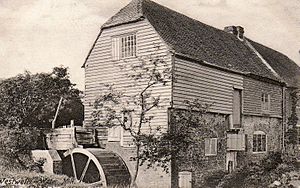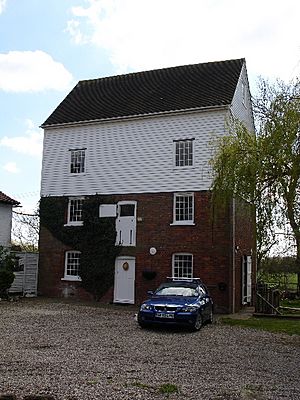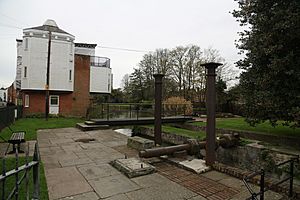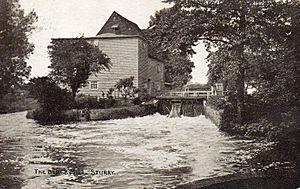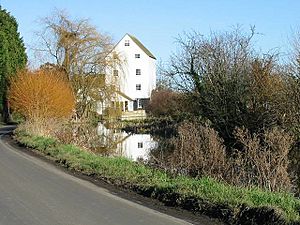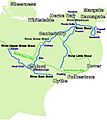Stour watermills facts for kids
The River Stour has been a source of power for hundreds of years. People used its flowing water to power many different machines. These machines helped with tasks like grinding corn into flour, making cloth thicker (fulling), producing paper, and even generating electricity. Today, many of these old mills have been turned into homes. However, two of them are still working commercially, continuing their important work!
Contents
- Mills on the Upper Great Stour
- Mills on the East Stour
- Mills on the Great Stour
- East Hill Mill, Ashford
- Wye Mill
- Chilham Mill
- Chartham Corn Mill
- Chartham Paper Mill
- Cock Mill, Canterbury
- Dean's (Westgate, Shafford's, Hooker's) Mill, Canterbury
- Barton Mill, Canterbury
- St. Mildred's Mill, Canterbury
- St. Mildred's Tannery, Canterbury
- King's Mill, Canterbury
- Abbott's (City, Denne's) Mill, Canterbury
- Black Mill, Sturry
- White Mill, Sturry
- Mills on Tributaries of Great Stour
- Mills on the Little Stour
- Images for kids
Mills on the Upper Great Stour
The top part of the Great Stour once powered eight watermills. Two more mills were found on smaller streams that flowed into it.
Bayton Mill, Lenham
This corn mill (a mill for grinding grain) in Lenham was the only one on the Upper Great Stour itself. Other mills in Lenham got their power from the River Len. The mill building is now a house, and all its old machinery is gone. It used to have a special type of waterwheel called a breastshot wheel.
Bowley Mill, Boughton Malherbe
This corn mill in Boughton Malherbe is now a ruined building. You can still see parts of the ground floor, the waterwheel, and some old machinery. The waterwheel was an overshot type, meaning water flowed over the top of it to make it turn. It was about 12 feet (3.7 meters) across and 6 feet (1.8 meters) wide. It was connected to a large cast-iron wheel with 96 teeth. The mill building was 30 feet (9.1 meters) by 15 feet (4.6 meters). New machinery was put in back in 1881. The upper parts of the mill were taken down in the 1960s because they were not safe anymore.
Burnt Mill, Charing
This corn mill at Charing is still standing, but it's also a ruin. Luckily, most of its old machinery is still inside! This mill was working until the mid-1950s. Its cast-iron waterwheel was about 10 feet 4 inches (3.15 meters) across and 5 feet (1.5 meters) wide. It even has the name "J HILL, ASHFORD, 1863" carved into it. A large wheel inside, called a pit wheel, had 80 teeth and helped turn the millstones. The Tanton family ran this mill for many years.
Field Mill, Charing
This corn mill at Charing is still standing, but it only has a little bit of its machinery left. It had an overshot waterwheel that was about 10 feet 6 inches (3.2 meters) across and 5 feet (1.5 meters) wide. This wheel also had a name carved into it: "HILL & SON ASHFORD 1877." The mill used to have two pairs of millstones to grind grain.
Swallow Mill, Little Chart
This corn mill at Little Chart had a waterwheel located inside the building. The Large family were the millers here in the 1850s and 1860s.
Ford Mill, Little Chart
This was a paper mill, meaning it made paper. It was making paper as early as 1776. The mill got its name from a ford (a shallow place to cross a river) that was nearby. A bridge replaced the ford in 1836. George Langley ran the mill from the 1840s until 1876. The mill's overshot waterwheel was later replaced by a turbine, which is a more modern way to use water power. In 1941, the mill started making a special material called flong for the Daily Express newspaper. However, making flong stopped in 1986 because of changes in the economy.
Worten Mill, Godinton
The mill at Godinton was a corn mill. The building is still there and has been turned into a home. This is one of the oldest mills in Kent, first mentioned in a document from 762! Even though it's in poor condition, the waterwheel is still inside the building.
Buxford Mill, Great Chart
Buxford Mill stopped being a corn mill after World War II. It was then used as a home, and later people tried to make it a restaurant and hotel, but these attempts didn't work out. The house was empty for a while before it became a private home again. The house you see today was built in 1600, but the waterwheel and all the mill machinery are now gone. There's still a small waterfall and a gate (sluice) next to the house.
Mills on Tributaries of the Upper Great Stour
Hothfield (Potters Corner) Mill
This corn mill, located north of Hothfield, still has most of its machinery! It stood on a small stream that flows into the Great Stour. It had a large cast-iron overshot waterwheel, about 11 feet (3.4 meters) across and 7 feet 6 inches (2.29 meters) wide. This wheel turned other gears and shafts to power the mill. It originally drove four pairs of millstones, but later only two pairs.
Westwell Mill
This corn mill at Westwell has been turned into a home. It still has its overshot waterwheel, which is a nice reminder of its past.
Mills on the East Stour
The East Stour river provided power for four watermills.
Evegate Mill, Smeeth
Hanover Mill, Mersham
The corn mill at Mersham is still working today! It is owned by T Denne and Sons, continuing the tradition of milling.
Swanton Mill, Mersham
This corn mill still has its machinery inside! It has an overshot waterwheel that is about 8 feet 4 inches (2.54 meters) wide and 6 feet 8 inches (2.03 meters) across. This wheel turns a cast-iron gear with 72 teeth. The mill originally had four pairs of millstones, but now only two remain. They are driven by a system of belts and pulleys. This setup was installed in the 1840s. The mill also had a steam engine built in 1840, which helped provide extra power. This engine was later moved to the Henry Ford Museum in America.
Sevington Mill, Willesborough
Sevington mill was a corn mill that had two overshot waterwheels. These wheels powered a total of five pairs of millstones. The mill was updated in 1852. Sadly, it burned down and was a ruin by 1939.
Mills on Tributaries of the East Stour
A stream that starts above Stowting flows into the East Stour near Evegate Mill. This stream also powered a watermill.
Stowting Mill
The millstones in this watermill were driven "overdrift," which means they were powered from above.
Mills on the Great Stour
The main part of the Great Stour powered sixteen watermills. There was also another mill on the Kennington Stream.
East Hill Mill, Ashford
This mill used both water and steam power to grind corn. It was one of the mills run by H.S. Pledge & Sons Ltd. The building has been converted and was used as a nightclub until 2014. There's a fake waterwheel on the outside. This was the only watermill in Ashford, which mostly had windmills and steam mills.
Wye Mill
The mill at Wye was run by the Denne family for many years. The building is still standing today and was carefully restored around the year 2000.
Chilham Mill
The large corn mill at Chilham is the best-preserved mill on the River Stour. Its waterwheel is very big, about 14 feet 6 inches (4.42 meters) across and 7 feet 10 inches (2.39 meters) wide. This huge wheel turns other gears to power six pairs of millstones. This mill is a great example of how these old machines worked.
Chartham Corn Mill
The building of this corn mill at Chartham is still here, but it's now a home and has no machinery. It was powered by a low breastshot waterwheel that was about 10 feet (3.0 meters) wide. There was also a turbine, about 4 feet (1.2 meters) across, which powered a pump.
Chartham Paper Mill
This mill is very old, even mentioned in the Domesday Book! It was a fulling mill (for cloth) in 1438, and paper production started around 1730. An interesting story is that tracing paper was discovered here when a worker accidentally added too much starch to the paper mixture. This paper mill is still working today, making tracing paper! It's owned by Arjo Wiggins.
Cock Mill, Canterbury
The River Stour splits into two streams as it goes through Canterbury. The western stream powered two watermills, and the eastern stream powered eight. Cock Mill was a small mill with just one waterwheel. It was taken down in the 1800s.
Dean's (Westgate, Shafford's, Hooker's) Mill, Canterbury
This was a corn mill. The mill was rebuilt around 1790 and had two waterwheels inside. These wheels powered eight pairs of millstones. William Hooker bought the mill in the 1890s and renamed it Westgate Mill. Sadly, the mill burned down in June 1954.
Barton Mill, Canterbury
These mills are on the eastern stream of the River Stour in Canterbury. Barton Mill was the last watermill in Canterbury that was still working for trade. For many years, it was a paper mill, and then it became a corn mill. It had two waterwheels that turned the millstones. Later, the millstones were replaced by roller mills, which are more modern. There was a fire in 1951, and after that, the mill was updated. Another fire in July 2004 finally ended milling at Barton Mill. Some of the buildings are still standing and have been turned into homes.
St. Mildred's Mill, Canterbury
This corn mill was located inside the city walls of Canterbury. It disappeared sometime in the Middle Ages.
St. Mildred's Tannery, Canterbury
The tannery (a place where leather is made) in Canterbury is on a very old site, even older than the famous cathedral! The current company was started in 1878 by Joseph and Samuel Conolly. The leather from this tannery was known for being very high quality. It was used in important places like the coronation coach of King Edward VII, in Rolls Royce cars, the Concorde airplane, the QE2 ship, Ferrari cars, and even the Houses of Parliament. The tannery buildings are now homes.
King's Mill, Canterbury
This corn mill was on a very old mill site. King Stephen gave the mill to St Augustine's Abbey in 1144. Later, in 1174, the Crown took it back and gave it to Rohesia, who was the sister of Thomas Becket. The mill was across from The Weavers House, and you can still see marks in the brickwork where the waterwheel used to be.
Abbott's (City, Denne's) Mill, Canterbury
This corn mill was built on the site of a medieval mill that belonged to the Abbot. The building itself was from 1792 and was first designed as a granary (a place to store grain) by John Smeaton. In 1794, it was turned into a watermill. The building was 60 feet (18 meters) square and six stories tall. The bottom part was brick, and the top five stories were made of wood. When it was built, it was the second tallest building in Canterbury, after the Cathedral! It had two waterwheels, each about 12 feet (3.7 meters) across and 6 feet (1.8 meters) wide. These wheels powered eight pairs of millstones. In 1896, Denne's bought the mill. Sadly, a fire destroyed the mill on October 17, 1933. The cast-iron axle from one of the waterwheels is still on the site.
Black Mill, Sturry
Sturry used to have two watermills, but neither of them are still standing today.
White Mill, Sturry
This corn mill has been torn down. Only small parts of the machinery remain. There's a turbine about 4 feet (1.2 meters) across and a low breastshot waterwheel that was about 14 feet 10 inches (4.52 meters) across and 7 feet 2 inches (2.18 meters) wide.
Mills on Tributaries of Great Stour
Kennington Mills
The mills at Kennington were powered by wind, steam, and water! The windmill was built in 1813. The millers in 1886 were Messrs. Pledge, who owned several mills in the Ashford area. The sails from the windmill were later moved to Pluckley windmill when Kennington mills closed. The windmill was empty by the 1930s and was torn down in 1952. The windmill was connected by a footbridge to the watermill building. The watermill was powered by the Kennington Stream.
Mills on the Little Stour
The Little Stour river provided power for four watermills.
Littlebourne (Hovis, Jarvis, White) Mill
Littlebourne mill was a corn mill with a breastshot waterwheel. The building is still standing and has been turned into a home. The mill was there in 1803. In 1820, a new, larger waterwheel was installed. In 1894, a company offered to install a new iron waterwheel. The mill was sold in 1944 and then modernized in 1945. It started using roller milling machinery and was powered by electricity. A big sign on the mill advertised Hovis flour. The mill closed by 1957 and was converted into a house in the early 1960s, with all its machinery removed.
Ickham Mill
Ickham mill was a corn mill. The building is still standing and has been converted into a home.
Wickhambreaux Mill
Wickhambreaux mill was a large corn mill. It had a brick base and four stories covered in wooden boards. The mill has been turned into apartments, but it still has its breastshot waterwheel.
Seaton Mill, Wickhambreaux
Seaton mill was a large mill. It had a breastshot waterwheel and a steam engine. The building is still standing and has been converted into a home.
Images for kids


